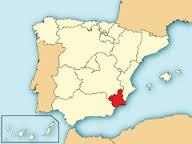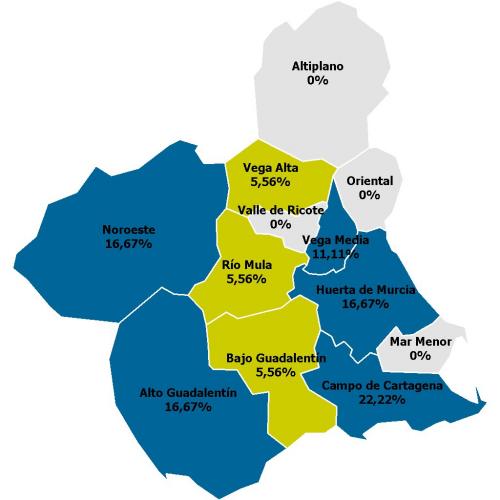
The Region of Murcia is an autonomous community of Spain located in the southeast of the country, between Andalusia and Valencian Community, on the Mediterranean coast.
The autonomous community consists of a single province, unlike most autonomous communities, which have several provinces within the same territory. Because of this, the autonomous community and the province are operated as one unit of government. The city of Murcia is the capital of the region and seat of government organs, except for the parliament (Regional Assembly), which is located in Cartagena. The autonomous community and province is subdivided into municipalities.
The Region of Murcia is bordered by Andalusia (the provinces of Almería and Granada); Castile–La Mancha (the province of Albacete, which was historically connected to Murcia until 1980); the Valencian Community (province of Alicante); and the Mediterranean Sea. The community measures 11,313 km² and has a population of 1.4 million,of whom one-third live in the capital. The highest mountain is Los Obispos (2,015 m).
The region is a major producer of fruits, vegetables, and flowers for Spain and the rest of Europe. Wineries have developed near the towns of Bullas, Yecla, and Jumilla, as well as olive oil near Moratalla. Murcia is mainly a warm region which has made it very suitable for agriculture. However the precipitation level is low and water supply is a hot subject today since, in addition to the traditional water demand for crops, there is now also a demand of water for the booming tourist developments which take advantage of the mild weather and beaches. Water is supplied by the Segura River and, ever since the 70's, by the Tajo transvasement, a major civil engineering which, under some environmental and sustainability restraints, brings water from the Tajo into the Segur.
 Comarcas (12) and municipalities (45) of the Murcia Region
Comarcas (12) and municipalities (45) of the Murcia Region
In the Region of Murcia are 12 comarcas, although they are not officially recognized or defined. The Autonomy Statute of the Region of Murcia set the region as one of the elements of its territorial organization, but Murcia Regional Assembly has not enacted any law of regionalization, so that, for now, these comarcas have no legal personality. The Autonomous Community of the Region of Murcia (CARM) is divided in just 45 municipalities. The number of municipalities is the lowest among the regions and the third lowest among the provinces,.
- Altiplano: 2 municipalities: Yecla and Jumilla
- Alto Guadalentín: 3 municipalities: Lorca, Águilas and Puerto Lumbreras
- Bajo Guadalentín: 5 municipalities: Mazarrón, Aledo, Alhama de Murcia, Librilla and Totana
- Campo de Cartagena: 3 municipalities: Cartagena, Fuente Alamo de Murcia and La Unión
- Huerta de Murcia: 4 municipalities: Murcia, Alcantarilla, Beniel and Santomera
- Mar Menor: 4 municipalities: San Javier, Los Alcázares, San Pedro del Pinatar and Torre-Pacheco
- Noroeste: 5 municipalities: Caravaca de la Cruz, Bullas, Calasparra, Cehegín and Moratalla
- Oriental: 2 municipalities: Fortuna and Abanilla
- Río Mula: 4 municipalities: Mula, Albudeite, Campos del Río and Pliego
- Valle de Ricote: 5 municipalities: Archena, Ojós, Ricote, Ulea and Villanueva del Río Segura
- Vega Alta del Segura: 3 municipalities: Cieza, Abaran and Blanca
- Vega Media del Segura: 5 municipalities: Molina de Segura, Alguazas, Ceutí, Lorquí and Las Torres de Cotillas.


